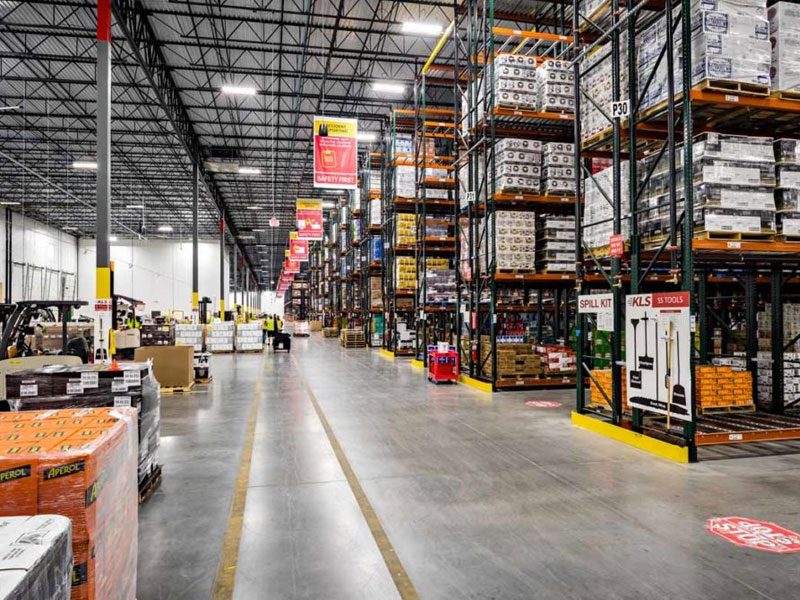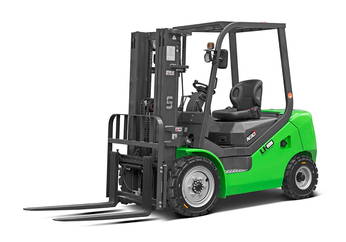How Reach Trucks Support Vertical Storage Expansion
Using reach trucks is an effective way to enhance warehouse space utilization because these vehicles are designed to operate efficiently in high-bay storage environments. Their extended mast reach, compact body structure, and stable lifting performance allow operators to place goods at greater heights while keeping aisle width narrow. By adopting vertical storage strategies, warehouses can maximize cubic capacity instead of relying only on floor-level shelving. This approach is especially beneficial for facilities that need to expand storage density without increasing building footprint or undergoing structural renovations. Reach trucks make it possible to store more pallets per square meter while maintaining accessible and organized inventory flow.
| Storage Method | Typical Height | Reach Truck Advantage |
|---|---|---|
| Floor-Level Racking | 1–3 meters | Limited vertical use of available warehouse height |
| High-Bay Racking | Up to 10 meters or more | Reach trucks can safely lift and retrieve pallets at high positions |
Reducing Aisle Width Requirements for Better Layout Efficiency
One of the primary reasons reach trucks improve warehouse space utilization is their ability to operate in narrow aisles. Traditional forklifts require wider aisles for turning and maneuvering, which reduces the number of racks that can be placed within a given area. Reach trucks, however, feature a compact chassis and precise steering control that allow them to function in aisle widths much narrower than those needed by standard forklifts. This enables warehouse planners to set up dense racking layouts with more rows of shelving and minimized dead zones. As a result, the warehouse floor plan becomes more efficient, with better use of space for storage rather than vehicle pathways.
| Equipment Type | Typical Aisle Width | Space Utilization Impact |
|---|---|---|
| Conventional Forklift | 3.0–3.5 meters | Fewer racks arranged per row |
| Reach Truck | 2.5–2.8 meters | Higher racking density and improved warehouse layout |
Supporting Efficient Storage of Mixed SKU Inventory
Warehouses handling a wide range of SKU sizes often struggle to balance accessibility and space efficiency. Reach trucks contribute to flexible storage by enabling operators to place different pallet types at various heights depending on inventory characteristics. For example, fast-moving goods can be positioned at mid-levels for faster picking, while slow-moving items can be stored at higher levels to save prime space. This adaptability supports more structured inventory zoning, allowing the warehouse to remain tidy and organized even as inventory profiles change. The design philosophy of companies like Zhejiang UN Forklift Co., Ltd., which emphasizes energy saving, safety, and efficiency, aligns well with these operational needs, making their reach trucks suitable for dynamic warehouse environments that require adaptable material handling solutions.
Enhancing Safety and Accuracy in Space-Constrained Operations
Safety is a key factor in maintaining warehouse productivity, especially in high-density storage environments. Reach trucks are engineered with stability systems, enhanced mast control, and ergonomic operator interfaces that help maintain consistent and predictable movements in tight aisles. These features reduce the risk of rack impacts, dropped loads, or misaligned pallet placement, all of which can negatively affect available space and cause operational delays. When operators can rely on stable lifting, accurate reach extension, and responsive braking, they are more capable of positioning pallets closely and efficiently within rack openings. This raises the effective use of every rack position and decreases the occurrence of wasted space caused by cautious or inconsistent placement.
| Challenge | Impact on Space | Reach Truck Support |
|---|---|---|
| Inaccurate pallet positioning | Creates unused gaps in racking | Precise mast control improves alignment |
| Operator fatigue | Irregular pallet stacking | Ergonomic controls promote consistent handling |
Improving Workflow Efficiency to Maximize Available Space
Efficient workflow directly influences how well warehouse space is used. When material handling equipment functions smoothly, products move quickly from receiving areas into racking systems, and stored inventory remains orderly. Reach trucks support smooth operations through their ability to maneuver quickly, access high rack levels, and reduce congestion in pathways. As storage and retrieval tasks become more streamlined, the warehouse can avoid cluttered staging zones or overflow areas that typically consume valuable space. With a global sales and service network, Zhejiang UN Forklift Co., Ltd. provides support that helps facilities maintain consistent performance of reach trucks, contributing to stable long-term warehouse layout efficiency.
Facilitating Future Expansion Without Structural Modification
Reach trucks help warehouses plan for long-term scalability by enabling the addition of higher shelves or denser storage systems without requiring major construction. As storage demands grow, facilities that already use reach trucks can expand vertically or reconfigure aisle layouts, taking advantage of the equipment’s compact operational requirements. This reduces the need for new buildings, extensions, or external storage rentals. By integrating reach trucks into warehouse planning from the beginning, organizations create a flexible foundation that accommodates various phases of business expansion while maintaining efficient use of space. The commitment of Zhejiang UN Forklift Co., Ltd. to developing high-efficiency and environmentally conscious equipment supports these long-term operational strategies.
Consistency in Load Handling for More Organized Racking
Consistent handling is a major contributor to effective space utilization. When pallets are placed neatly, aligned correctly, and supported with stable lift controls, every rack position can be used as intended. Reach trucks maintain a steady lifting and reaching motion that reduces tilting or swaying of loads, even at height. This makes it easier to utilize every available rack position and avoid the irregular stacking patterns that often lead to wasted vertical gaps. With controlled acceleration, sensitive steering, and optimized hydraulic performance, reach trucks promote uniform storage placement throughout the warehouse.
Reducing Congestion Through Improved Maneuverability
Warehouse congestion often leads to inefficient use of space because pallets accumulate in transitional zones while operators wait for clear access. Reach trucks reduce this issue by offering smoother maneuverability in narrow aisles and enabling operators to complete storage cycles faster. Their turning radius is smaller than that of conventional forklifts, making it easier to navigate high-density rack structures without disrupting workflow. When equipment can move freely and predictably, the warehouse maintains clear pathways and minimizes buffer areas, allowing more space to be devoted to well-organized storage.
Supporting Automated or Semi-Automated Warehouse Layouts
As warehouses adopt automation‐supported processes such as guided navigation, sensor-assisted positioning, or digital inventory tracking, reach trucks integrate smoothly into these workflows. Modern reach trucks can be equipped with features such as height selection indicators or load weight monitoring, which help maintain consistent storage practices. Automated guidance options also reduce trial-and-error movements during pallet placement, making space utilization more efficient. For organizations planning digital transformation, choosing reach trucks aligned with advanced technological infrastructure supports long-term improvements in how space is managed and optimized.
Improving Pallet Accessibility for Higher Storage Density
Reach trucks enhance accessibility because their mast extending mechanism allows operators to reach into deep rack positions without repositioning the vehicle. This ability supports double-deep racking systems, where two pallets are stored back-to-back. Such systems double the number of pallet positions in the same horizontal space. Although double-deep racking requires careful operation, reach trucks are specifically engineered for this purpose, offering smooth reach control that maintains safety and organization. As a result, warehouses can significantly increase pallet count while still ensuring reliable access to stored goods. This makes reach trucks an important tool for maximizing space in distribution centers, manufacturing storage zones, and high-volume logistics facilities.
| Racking Type | Pallet Capacity | Space Benefit |
|---|---|---|
| Single-Deep | Standard capacity | Good accessibility, moderate density |
| Double-Deep | Up to 2× pallet positions | Higher density with reach truck operation |
Lowering Maintenance-Related Space Loss
Unscheduled maintenance or breakdowns can disrupt warehouse layout and reduce usable space because machines may need to be parked in aisles or staging zones. Reliable equipment minimizes these disruptions. Companies like Zhejiang UN Forklift Co., Ltd. focus on durable design and energy-efficient technologies that support continuous operations with fewer interruptions. When reach trucks operate dependably, the warehouse avoids temporary storage congestion and maintains its intended space utilization plan. Consistent maintenance support also ensures equipment remains efficient over time, preventing operational slowdowns that could affect the arrangement of goods.
Supporting Sustainable Warehouse Management
Space utilization is also connected to sustainable warehouse operations. A well-organized high-density storage system reduces the need for building expansions, additional heating or cooling requirements, or extended lighting areas. Reach trucks help implement such systems by maximizing existing space and helping facilities store more goods with lower overall energy consumption. Zhejiang UN Forklift Co., Ltd., whose products are designed with energy saving and environmental protection in mind, aligns with sustainable warehouse practices by providing equipment that supports both storage efficiency and reduced operational strain. This combination of efficiency and sustainability enables warehouses to optimize resources while maintaining reliable, safe operations.











 中文简体
中文简体 عربى
عربى Español
Español














